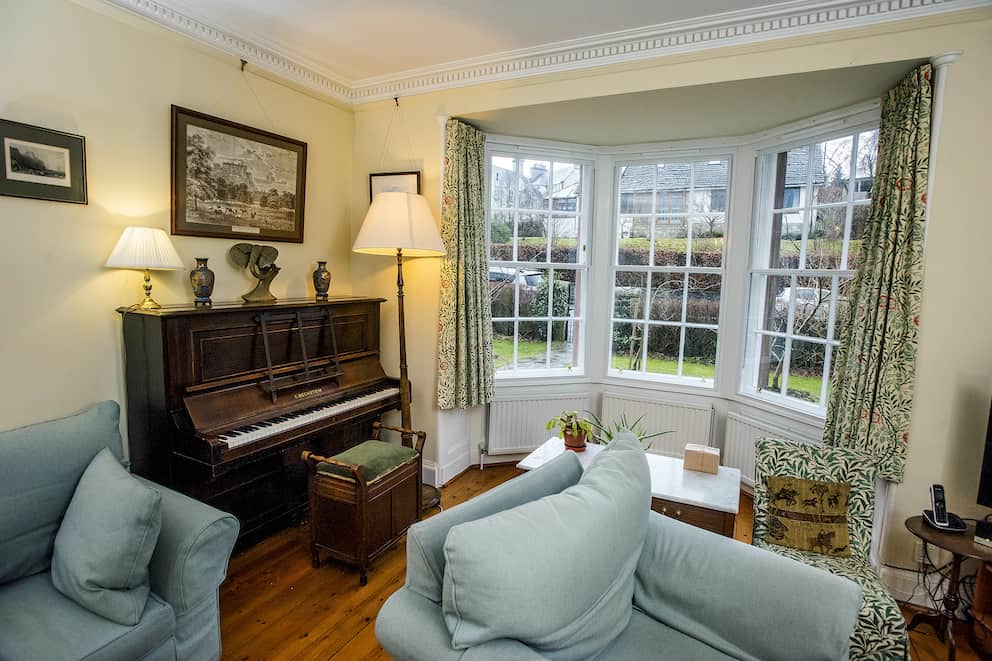Did you know that secondary glazing vs double glazing is one of the most important decisions a homeowner can make to reduce their energy bills? According to studies, the average home is losing up to 10 percent of its heat through windows. This loss of heat isn’t just uncomfortable, it’s pricey.
Whereas reducing heat loss by up to 50 percent and saving between £50 to £175 annually in energy bills are the advantages of double glazing, secondary glazing offers an alternative approach. What is secondary glazing? It’s a second pan of glass installed on the inside of your existing windows, creating an insulating airspace of 150-200mm that can reduce heat loss by as much as 65%. How does double glazing work? It uses two panes of glass with an internal sealed gap. Also, secondary glazing is typically less expensive than double glazing, thus an attractive option for most homeowners, especially those owning listed homes where planning permission could be an issue. In reality, if you fitted secondary glazing on all the windows of an average three-bedroom house, you would be saving approximately £75 a year.
By the time you reach the end of this guide, we’ll help you decide whether secondary glazing is worthwhile for your specific situation, or if double glazing is the better option. We’ll compare everything from thermal efficiency to soundproofing, security features, and long-term value to help you make the perfect choice for your home.
What is double glazing?
Double glazing consists of two panes of glass with a sealed gap of typically 16mm between them. The gap can be filled with air, but more commonly with inert gases like argon, which is 33% better at thermal insulation than air. The package is a sealed unit that resists heat flow between your home and the outside world.
C.D. Haven invented contemporary double glazing in 1930 in the USA and brought it to the UK in the 1970s when fuel prices were on the rise. The windows feature rubber gaskets on their edges that form an airtight seal, keeping water out and stopping heat from escaping.
What is secondary glazing?
Secondary glazing, however, is the installation of an additional window on the room side of your original window. This offers a totally independent internal window that can enhance your original windows rather than replacing them. Secondary glazing can exist in numerous forms, including horizontal sliders, vertical sliders, and removable fixed panels.
Secondary glazing is distinct from double glazing because it does not mean taking out your existing windows, so it is most useful for listed buildings or properties where original features must be preserved. It creates double glazing from your existing single-glazed window, resulting in a less invasive solution.
How do they compare?
Historical preservation
In new buildings, where Building Regulations make double glazing virtually compulsory, double glazing can lead to energy savings. However, in period property, replacing original windows with double glazed units can create a dramatic, unattractive change in a property’s appearance, because of the need for thicker timber sections and glazing bars, and the flatness of new glass. Double glazing is not normally permitted in listed buildings, in order to protect the original appearance.
To maintain a period property’s authenticity, fitting secondary glazing and repairing and renovating the original windows rather than replacing them is the better option. This is especially true in buildings with decorative windows that have survived centuries. Simply put, double glazing means a loss of historic fabric.
Less waste
Disposing of the original primary window and introducing a bulkier, new double glazing uses more than 3 times the materials compared to a secondary system. Factor in that secondary glazing requires no re-decoration and it’s easy to see why choosing secondary glazing is less damaging to the environment.
Unlike double glazing, secondary glazing is usually recyclable. Should you ever need to change or upgrade your secondary glazing, disposal involves minimal waste.
Thermal insulation
As previously mentioned, double glazing’s benefits can be overstated compared to other glazing methods. Enhanced energy efficiency and comfort is not just the preserve of double glazing! Significant draught reduction is also a major benefit of secondary glazing. Technical advances and modern production methods make it possible for secondary glazed windows to exceed the performance of double glazed windows.
This not only reduces your environmental impact, but reduces the cost to keep your home warm by as much as 15%. Particularly as energy costs soar, this can be the difference between a warm winter or a chilly season.
Noise reduction
Wherever you live, outside noise can have a real impact on your quality of life. For noise reduction, double glazing is often no more effective than single glazed units, in fact for traffic noise reduction, they can perform less effectively. The overriding factor in noise reduction is well fitted, draught-proofed windows.
Secondary glazing’s larger gap between glass panes is a better noise insulator, as the sound waves get lost before they get inside. In fact, some people choose to get secondary glazing even if they already have double glazing, due to the superior noise insulation. This way, they can be confident that the outdoor world won’t disturb your sleep or work.
Security
Secondary glazing also provides a level of security that doesn’t come with double glazing. As windows and doors are one of the main entry points for intruders, they need the most security to protect your property.
Double glazing involves thickening the glass, but if a burglar forces the lock, they can get inside. By installing secondary glazing, you add a whole extra structure that trespassers would have to break through. Many secondary glazing can also be reinforced, both in the glass itself and in the locks.
Condensation prevention
Both double and secondary glazing use a similar principle to prevent condensation. Condensation occurs when warm air comes into contact with cold surfaces, in this case the window. The moisture in the air is cooled down so much that it condenses into a liquid, known as condensation.
However, this can be prevented by adding a second layer of glass, trapping air between the two. The air prevents the inside pane from becoming as cold as the outside pane, meaning that the air inside doesn’t cool enough to become liquid.
Both double glazing and secondary glazing use this method, but the way that secondary glazing works gives you more control. Many types of secondary glazing allow you access between the panes of glass. If the problem persists even after window renovation, you can place silica bags between the windows to absorb residual moisture.
Cost and installation: What to expect
Financially, secondary glazing is appreciably cheaper than double glazing. Secondary glazing can cost anywhere from £300-£500 per window, roughly half the cost of double glazing installation.
In terms of installation, double glazing involves complete replacement of older windows, including removal of existing frames and professional installation. Or secondary glazing fitting is less invasive, typically completed in a day on 4-8 windows with no significant structural alteration.
In value for the long term, although double glazing entails higher upfront costs, its superior energy efficiency may be more beneficial in the longer run. Secondary glazing realises returns in 3-8 years depending on type, whereas double glazing would serve for around 20-45 years depending on material.
Lastly, where there are listed buildings or conservation properties under restraint, secondary glazing is the most convenient solution, with some 80% cost savings compared to replacement double glazing.
What Clearview Secondary Glazing recommend
As industry specialists, we offer tailored recommendations based on your specific needs. Our experts know that simply installing secondary glazing provides substantial benefits, with glass selection primarily fine-tuning the final performance.
For noise reduction, our experts advise maximizing the air gap between glasses. An optimal distance of 150-200mm delivers superior results, potentially reducing noise ingress by up to 75% (exceeding 50dB). If space constraints limit this gap, thicker or acoustic glass can offset some limitations.
Regarding thermal efficiency, we know a more modest 50-80mm air gap is sufficient. Our secondary glazing typically delivers a 60-70% improvement in thermal performance. For condensation issues, which secondary glazing significantly reduces but cannot guarantee complete elimination, following these thermal principles provides effective management.
Clearview manufactures our range using environmentally responsible materials from managed sources, combining quality timber sub-frames with powder-coated aluminium for strength with narrower profiles. Our comprehensive range suits nearly all window styles, from modern offices to 17th-century Grade I listed buildings.
Our systems arrive fully assembled, pre-glazed, and installation-ready in most cases, with standard units dispatched within 21 days. For particularly large dimensions (both over 1800mm), units are supplied flat-packed with a surcharge.
Choosing the right option
Once both the solutions have been carefully reviewed, we think the choice between double glazing and secondary glazing depends mostly on your individual home requirements and budget. Secondary glazing certainly has its benefits, especially for listed building owners or those who wish to preserve original window features.
This option restricts heat loss by as much as 65-70%, is better at damping noise with its larger air gap, and provides more security in the guise of an additional physical barrier.
Double glazing, however, is renowned for enhanced heat efficiency, restricting heat loss by as much as 90%. Although more expensive initially, this option can conserve more energy over its 20-45 year lifespan.
Cost-wise, secondary glazing also has a compelling case at half the price of double glazing. Secondary glazing is also installed at pace without drastic disruption to your home.
We believe the best solution is to take into account your greatest needs. If noise reduction and maintaining original windows are of the greatest importance when fitting a tighter budget, secondary glazing is the reasonable option. If optimum energy efficiency is your primary concerns and planning limitations pose no issue, double glazing might be the worthwhile investment.
Whatever your decision, both will make your home far more comfortable, save on energy costs, and provide greater security than single glazing. Ultimately, the choice depends on weighing up your short-term budget against long-term performance requirements and any possible constraints that may be imposed upon your property.
You can get a free online quote from our experts, or speak to us to get more information from our team.
Further comparison
If you are weighing up the benefits of secondary glazing, these pages and downloads may help:



